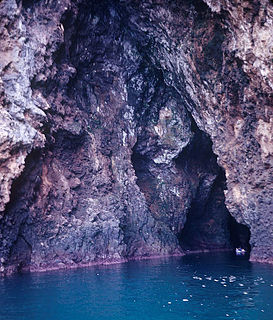 W
WA sea cave, also known as a littoral cave, is a type of cave formed primarily by the wave action of the sea. The primary process involved is erosion. Sea caves are found throughout the world, actively forming along present coastlines and as relict sea caves on former coastlines. Some of the largest wave-cut caves in the world are found on the coast of Norway, but are now 100 feet or more above present sea level. These would still be classified as littoral caves. By contrast, in places like Thailand's Phang Nga Bay, solutionally formed caves in limestone have been flooded by the rising sea and are now subject to littoral erosion, representing a new phase of their enlargement.
 W
WThe Amberjack Hole is a blue hole located 48 km (30 mi) off the coast of Sarasota, Florida. The rim of the hole is approximately 34 m (112 ft) below the surface, and extends down approximated 72 m (236 ft).
 W
WA blue hole is a large marine cavern or sinkhole, which is open to the surface and has developed in a bank or island composed of a carbonate bedrock. Their existence was first discovered in the late 20th century by fishermen and recreational divers. Blue holes typically contain tidally influenced water of fresh, marine, or mixed chemistry. They extend below sea level for most of their depth and may provide access to submerged cave passages. Well-known examples can be found in South China Sea, Belize, the Bahamas, Guam, Australia, and Egypt.
 W
WThe Green Banana Hole is a blue hole 80 km (50 mi) off the coast southwest of Sarasota, Florida. The rim is approximately 47 m (154 ft) below the surface and the hole extends downward approximately 130 m (427 ft). Blue holes in this area are thought to have formed as sinkholes on land 8,000 to 12,000 years ago. Due to lower sea levels at this time, the Florida coastline extended approximately 161 km (100 mi) farther into the ocean. The vertical shape of the hole is roughly like an hourglass, making it especially difficult to explore. It is one of the deepest known blue holes.
 W
WThe Animal Flower Cave is located under the cliffs at North Point, St. Lucy, Barbados. It is the island's lone accessible sea cave. It was discovered by its seaward entrance in 1780 by two English explorers. The cave stands six feet above the high water mark although it was formed at sea level. This has occurred because Barbados is rising at 1 inch per 1000 years.
 W
WBaxian Caves are sea caves located in the east coast of Changbin Township, Taitung County, Taiwan.
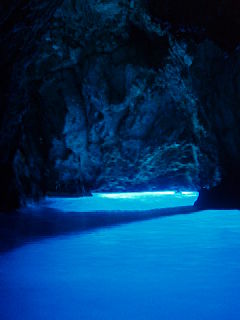 W
WThe Blue Grotto or Blue Cave, is a waterlogged sea cave located in a small bay called Balun, on the east side of the island of Biševo and about 4.5 nautical miles (8.3 km) from Komiža, in the Croatian Adriatic. It is situated in the central Dalmatian archipelago, 5 km south-west of the island of Vis. The grotto is one of the best known natural beauty spots on the Adriatic and a popular show cave because of the glowing blue light that appears at certain times of day.
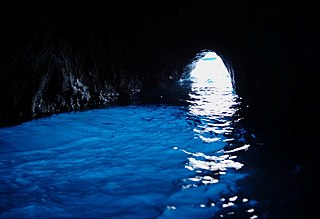 W
WThe Blue Grotto is a sea cave on the coast of the island of Capri, southern Italy. Sunlight passing through an underwater cavity and shining through the seawater creates a blue reflection that illuminates the cavern. The cave extends some 50 metres into the cliff at the surface, and is about 150 metres (490 ft) deep, with a sandy bottom.
 W
WThe Blue Grotto refers to a number of sea caverns on the south east coast of Malta, a short distance off the fishermen's harbour of Wied iż-Żurrieq limits of Qrendi, Malta
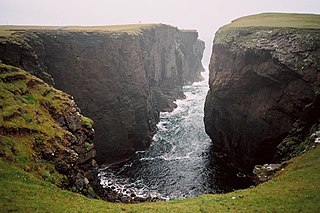 W
WCalders Geo is an inlet in the western cliffs of Esha Ness in Northmavine on the Mainland, Shetland, Scotland. A cave on the north side of the geo has been measured at more than one and a half times the size of "The Frozen Deep", a chamber in Reservoir Hole under Cheddar Gorge in Somerset, potentially making it the largest natural chamber in Britain.
 W
WThe Cathedral Caves are one of the thirty longest sea caves in the world, located on Waipati Beach, 15 kilometres (9.3 mi) south of Papatowai, on the Catlins Coast in the southeast corner of the South Island, New Zealand. They are one of the most popular tourist attractions in the area, along with the McLean Falls, the highest water falls in the Catlins, located 4.9 kilometres (3.0 mi) away. The two main cave systems join together within the cliff and one has a 30 metres (98 ft) high ceiling. Often blue penguins and fur seals will emerge from the gloom at the far end of the cave.
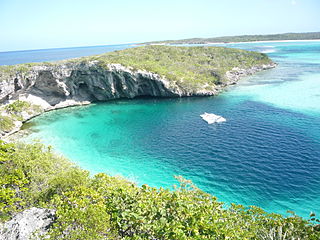 W
WDean's Blue Hole is a blue hole located in The Bahamas in a bay west of Clarence Town on Long Island and is the world's second deepest, after the Dragon Hole in the South China Sea, with a depth of 202 metres (663 ft).
 W
WDragon Hole, also known as Yongle Blue Hole named after the third Ming emperor, is the deepest known blue hole in the world at 300.89 metres (987.2 ft) deep. It is located about 25 kilometres (16 mi) south of Discovery Reef in the Paracel Islands. Blue holes generate a distinctive blue colour when seen from above. They are characteristically only dozens of metres deep.
 W
WFingal's Cave is a sea cave on the uninhabited island of Staffa, in the Inner Hebrides of Scotland, known for its natural acoustics. The National Trust for Scotland owns the cave as part of a national nature reserve. It became known as Fingal's Cave after the eponymous hero of an epic poem by 18th-century Scots poet-historian James Macpherson.
 W
WThe Gloup is a collapsed sea cave in the Mull Head Nature Reserve in the islands of Orkney, Scotland.
 W
WThe Great Blue Hole is a giant marine sinkhole off the coast of Belize. It lies near the center of Lighthouse Reef, a small atoll 70 km (43 mi) from the mainland and Belize City. The hole is circular in shape, 318 m (1,043 ft) across and 124 m (407 ft) deep. It was formed during several episodes of quaternary glaciation when sea levels were much lower. Analysis of stalactites found in the Great Blue Hole shows that formation took place 153,000; 66,000; 60,000; and 15,000 years ago. As the ocean began to rise again, the cave was flooded. The Great Blue Hole is a part of the larger Belize Barrier Reef Reserve System, a World Heritage Site of the United Nations Educational, Scientific and Cultural Organization (UNESCO).
 W
WCaves of Nanumanga is an underwater cave off the northern shore of Nanumanga, Tuvalu in western Polynesia. It was discovered by two scuba divers in 1986.
 W
WNereo Cave is a huge underwater sea-cave situated on the north-west of Sardinia in the Coral riviera of Alghero, Italy. The name was given by the discovers in honour of the mythological figure Nereus, who is often billed as the Old Man of the Sea, father of the Nereids. The site is under the high limestone cliffs of Capo Caccia, 100 metres north of the famous Neptune's Grotto.
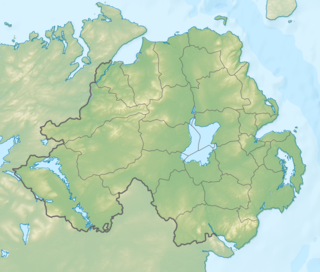 W
WPortbraddon Cave is a relict sea cave located near Portbraddon, County Antrim on the north coast of Northern Ireland. Its location 5 m (16 ft) above the present-day high water mark makes it important archaeologically, as it would have been inhabited as far back as the Mesolithic.
 W
WRosh HaNikra or Hanikra is a geologic formation on the border between Israel and Lebanon, located on the coast of the Mediterranean Sea, in the Western Galilee. It is a white chalk cliff face which opens up into spectacular grottos.
 W
WSea Lion Caves is a connected system of sea caves and caverns open to the Pacific Ocean in the U.S. state of Oregon. They are located 11 miles (18 km) north of Florence on U.S. Highway 101, about midpoint on the 400 miles (640 km) Oregon Coast. In this area Highway 101 follows a steep and undeveloped seascape 300 feet (91 m) above sea level. Human access to the caves is through a gift shop building.
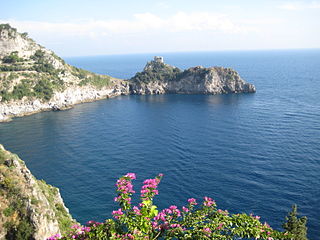 W
WThe Grotta dello Smeraldo is a cave, partly inundated by the sea and located in Conca dei Marini, Italy, on the Amalfi Coast.
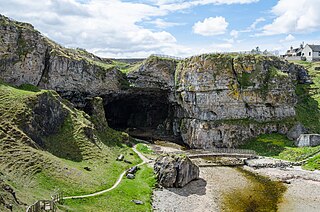 W
WSmoo Cave is a large combined sea cave and freshwater cave in Durness in Sutherland, Highland, Scotland. The cave name is thought to originate from the Norse 'smjugg' or 'smuga', meaning a hole or hiding-place.
 W
WXian Dong Yan (仙洞巖), also called Fairy cave or Deity's cave, is a natural sea cave in Zhongshan District, Keelung, Taiwan. It is a designated Cultural Landscape by the Bureau of Cultural Heritage in Taiwan. The cave was a shrine and resting place for fishermen during Qing dynasty period and was converted into a Buddhist Temple since Japanese occupation period.